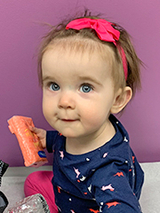Lily’s Story: Congenital Diaphragmatic Hernia Repair
Lily’s Story: Congenital Diaphragmatic Hernia Repair
Laura and Nick expected to learn a few things at the 20-week anatomy scan for their second child, Lillian Jane (nicknamed Lily). The sex of the baby was at the top of the list. What they didn’t expect to be told was that Lily had a life-threatening birth defect. They were devastated. Fast forward to today: 9-month-old Lily is home and doing well.

“I just cried and cried,” Laura says of the day she learned Lily had congenital diaphragmatic hernia (CDH). “The doctor said the odds might not be very good, locally.”
The obstetrician referred the family to Children’s Hospital of Philadelphia (CHOP), whose Center for Fetal Diagnosis and Treatment handles the largest number of CDH cases in the country. Laura was relieved to know a place with such expertise was just a two-hour drive away from their home near Wilkes Barre, Pa.
“I was comfortable knowing that CHOP was the place to be,” she says. “I’ve had many family and friends go there with successful stories, and so I knew that if there was any place that could help us, it was CHOP.”
Driving south for CDH expertise
While Laura’s mother looked after their 2-year-old son, Lucas, the couple drove south to CHOP. After a day of diagnostic testing, the center’s care team went over the condition in detail and walked the couple through what the next few months might look like.
The plan was for Laura to have regular ultrasounds back home and monthly ultrasounds at CHOP. Then, at 36 weeks, she would relocate closer to Philadelphia to be near CHOP if she went into preterm labor. Delivery would take place in CHOP’s Garbose Family Special Delivery Unit (SDU). After birth, Lily’s surgery and care would be handled by a team with special expertise in CDH.
“We felt confident that she was in good hands,” says Nick. “They knew what they were doing.”
The couple returned home to find an outpouring of support from family members, friends and their community. Laura’s coworkers hosted a local spaghetti dinner fundraiser, and friends and neighbors offered to pick Lucas up from daycare.
The center’s psychosocial team also provided Nick and Laura with counseling services, tips for explaining the diagnosis to their son, and spiritual support. CHOP is one of the first hospitals in the country to see the value in meeting all of a family’s needs, whether medical, emotional or spiritual. CHOP’s Schlimm Center for Prayer and Reflection was a calm, welcoming respite for Laura, who filled out prayer requests throughout the experience.
Delivery, CDH repair and N/IICU stay
CDH can impact the development of the lungs and cause breathing issues after birth. Depending on the severity of the condition, babies can be in the N/IICU for anywhere from one to eight months.
Lily was born kicking and screaming, literally, which her dad took as a good sign. She needed a ventilator for breathing support for a few days and struggled with feeding issues from gastroesophageal reflux, but overall, she was very fortunate.
Within just 48 hours, she was stable enough to undergo surgical repair of her diaphragm. At Laura’s request, CHOP’s chaplain said a prayer at Lily’s bedside before the surgery. The surgery was a success, and after a little less than a month, Lily was able to go home.
“Every piece of the puzzle that needed to fall into place fell into place and worked to our advantage,” says Nick. “She just kept breaking records.”
Keeping families connected and preparing them for life at home
While in the N/IICU, lactation consultants helped Laura with pumping and storing breast milk. Using the N/IICU’s bedside web camera, Nick, who had to return home to work and care for Lucas, was able to see Lily on his smartphone between deliveries for his company, FedEx. Lily’s grandmothers and other extended family members were also able to log in and see her. They called it “Lily cam.”
Before discharge, speech and occupational therapists taught Laura special feeding techniques to minimize reflux and nurses instructed her on how to work around Lily’s surgical site when changing her diaper.
“It was a little intimidating in the beginning,” recalls Laura. “But it was worth the practice, because then you get home and you're not worried about those things.”
Lily recently celebrated her first birthday and had her one-year appointment with the Pulmonary Hypoplasia Program.

“Everything is going well,” says Laura, who notes that Lily’s affected lung is growing and she has remained stable, even while being sick with COVID. “She’s busy crawling, babbling and trying to climb/walk wherever she can!” Lily is on track with all of her milestones. She attends a medical daycare where she receives extra monitoring every day, and she has physical therapy to strengthen her muscles and help her continue to develop gross motor skills.
“She's definitely a fighter,” says Laura.
Having been discharged from the N/IICU during flu season and the onset of the COVID-19 pandemic, Lily has spent most of her life in quarantine to limit her exposure. Fortunately, the family’s journey from prenatal diagnosis of CDH to discharge home is featured in a CFDT video, which they’ve been able to share with extended family members and friends who believed in Lily and supported the family before she was even born.
“Even after watching it 100 times, I still cry,” says Laura of the video. “Our families and friends have loved it and shared it with so many people. We will surely treasure it for the rest of our lives.”